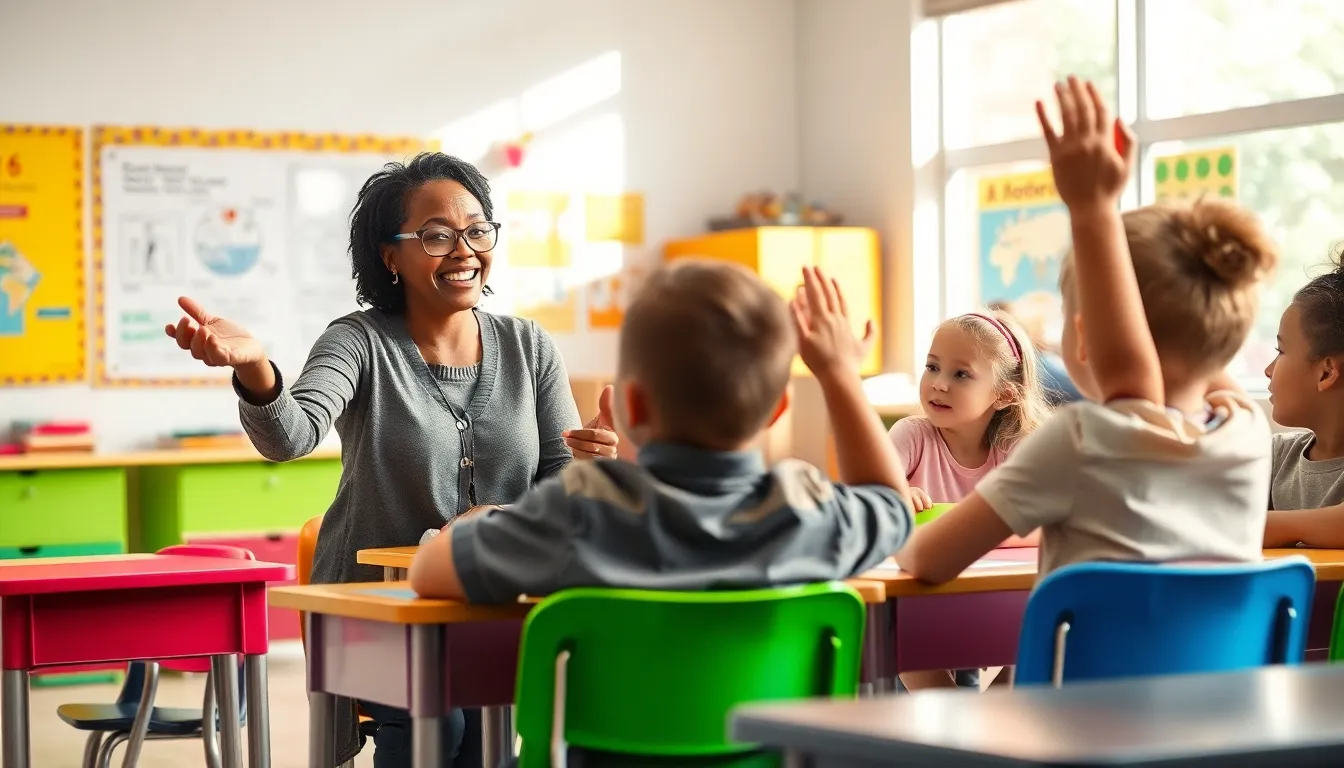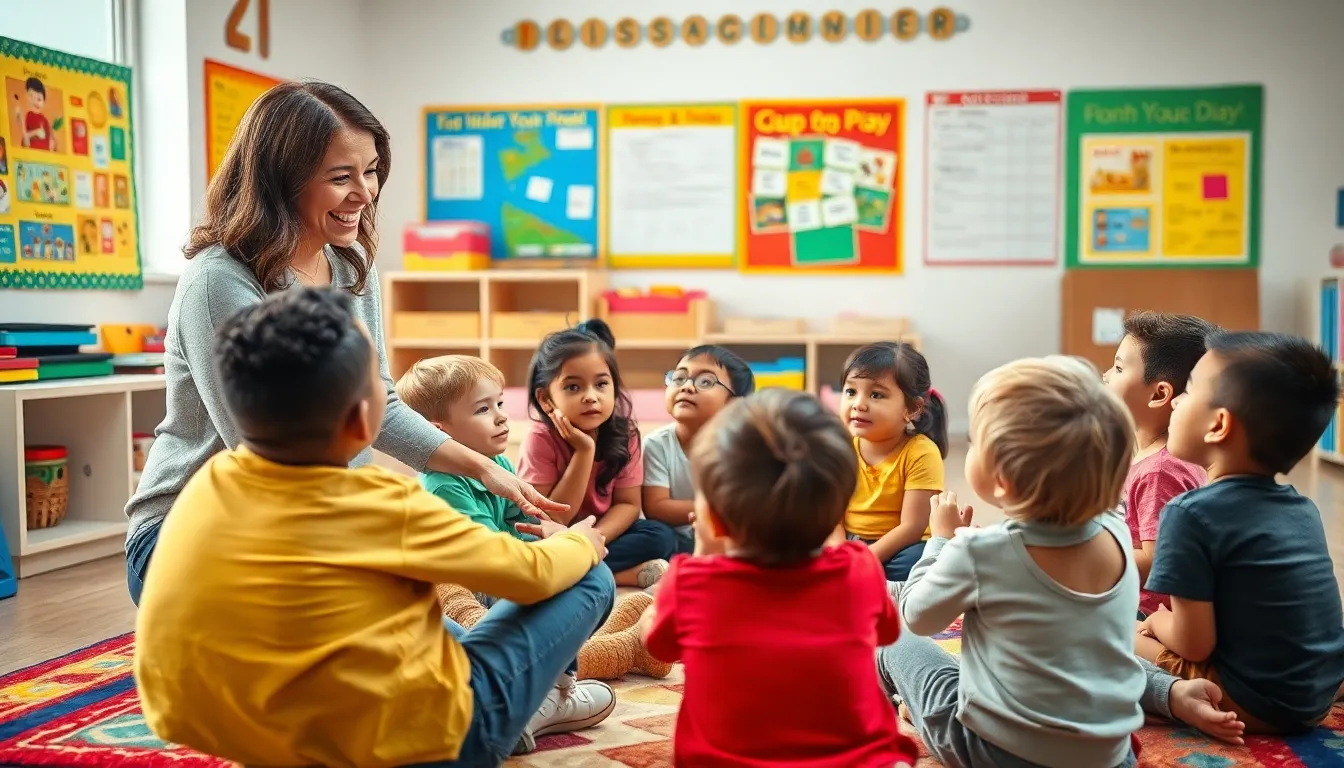In the bustling world of education, the magic often lies in the interactions between teachers and their students. Picture a classroom where curiosity reigns and laughter echoes—a place where a simple question can spark a lifelong love for learning. Teacher-child interactions aren’t just about imparting knowledge; they’re about building connections that inspire, motivate, and sometimes even entertain.
When teachers engage with students in meaningful ways, they create a vibrant atmosphere where creativity flourishes and confidence grows. Whether it’s a playful banter over math problems or a heartwarming chat about a favorite book, these moments shape young minds in ways that textbooks simply can’t. So, let’s dive into the art of teacher-child interactions and discover how they can transform the educational experience into something unforgettable.
Table of Contents
ToggleOverview of Teacher-Child Interactions
Teacher-child interactions encompass a range of verbal and non-verbal exchanges that occur within the classroom. These exchanges play a crucial role in shaping a child’s learning experience. Engaging in positive interactions encourages children to express their thoughts and emotions, fostering a greater sense of belonging.
Furthermore, teachers utilize various strategies to enhance these interactions. They often employ open-ended questions, which stimulate critical thinking and invite children to explore their ideas. Active listening also features prominently; when teachers attentively respond to children’s comments, it builds trust and strengthens relationships.
Consistent interaction has significant benefits. Research indicates that students involved in high-quality teacher-child interactions develop better social skills and academic outcomes. Increased engagement leads to improved motivation and a deeper interest in learning topics.
In addition, these interactions contribute to a child’s emotional well-being. When teachers show empathy and understanding, it creates a supportive environment where children feel safe to take risks and make mistakes. Such an atmosphere nurtures resilience and self-confidence among students.
By prioritizing these connections, educators not only enhance learning but also influence children’s overall development. Attention to individual needs and preferences ensures that all students feel valued. Diverse interaction styles cater to various learning modalities, promoting inclusivity and effective communication within the classroom.
Importance of Teacher-Child Interactions
Teacher-child interactions play a vital role in shaping educational experiences, facilitating both learning and development. Engagement in the classroom leads to more significant benefits for students.
Impact on Learning Outcomes
Positive teacher-child interactions correlate strongly with improved learning outcomes. Research indicates that children exposed to stimulating dialogue demonstrate greater cognitive skills. When teachers encourage open discussions, they foster critical thinking among students. Children who engage frequently with their teachers show enhanced problem-solving abilities. Constructive feedback from instructors boosts academic confidence, promoting a love for learning. Increased motivation stems from consistent, supportive interactions that recognize each child’s strengths. Additionally, active participation in discussions leads to deeper understanding and retention of knowledge.
Emotional and Social Development
Teacher-child interactions significantly influence emotional and social development. Children feel secure and valued in supportive classroom environments. Empathetic teachers create spaces where students learn to express their emotions freely. When educators model effective communication, they cultivate essential social skills among peers. Students build strong relationships with their teachers, fostering trust that encourages collaboration. Children learn to navigate social complexities through guided interactions with their instructors. Emotional intelligence develops naturally as teachers promote resilience and self-confidence. Overall, these relationships enhance children’s well-being, nurturing their ability to thrive in diverse settings.
Types of Teacher-Child Interactions
Teacher-child interactions manifest in various forms, primarily through verbal and non-verbal communication. These types significantly impact a child’s learning experience and emotional development.
Verbal Interactions
Teachers often use verbal interactions to engage students effectively. Questions stimulate critical thinking; discussions promote deeper understanding. Open-ended questions encourage children to articulate their thoughts, fostering creativity. Additionally, teachers provide constructive feedback, enhancing students’ academic confidence. Conversations about different topics not only advance learning but also build rapport. When teachers actively listen, they create a trusting environment that encourages expression. Positive affirmations during these interactions help bolster students’ motivation and enthusiasm. Engaging in dialogue with children nurtures their language skills and encourages them to participate in classroom discussions.
Non-Verbal Interactions
Non-verbal interactions play a crucial role in communicating support and understanding. Teachers use body language, facial expressions, and eye contact to convey attention and care. A warm smile or nod can significantly boost a child’s confidence. Proximity, like sitting close to a child while discussing, shows that the teacher values their input. Gestures often reinforce verbal messages, creating clarity in communication. Furthermore, attentive listening, displayed through bodily posture, signals that the teacher prioritizes the child’s contributions. Creating a welcoming atmosphere through these interactions helps children feel secure and accepted in the learning environment, fostering emotional growth.
Strategies for Effective Interactions
Effective teacher-child interactions are pivotal for fostering a supportive learning environment. Strategies that enhance these interactions can lead to improved educational outcomes.
Building Relationships
Establishing strong relationships forms the foundation of effective interactions. Teachers should show genuine interest in each child’s thoughts and feelings. Regular one-on-one time fosters trust and communicates that students are valued. Personal connections encourage children to express themselves, enhancing their emotional well-being. Teachers might share their own experiences to create relatability, leading to deeper connections. Celebrating each child’s achievements, no matter how small, reinforces positive relationships. Strong bonds encourage open dialogue, allowing students to feel safe and engaged in the learning process. Maintaining consistency in interactions solidifies trust, making children more comfortable in the classroom.
Encouraging Engagement
Promoting engagement requires active participation from both teachers and students. Utilizing open-ended questions stimulates deeper thinking and creativity. Engaging activities may incorporate hands-on learning, allowing students to explore topics in dynamic ways. Incorporating relevant and relatable materials keeps children interested and motivated to participate. Encouraging group discussions fosters collaboration, where students learn from one another. Varied teaching methods, such as storytelling or interactive games, can spark curiosity. Giving timely feedback also encourages students to stay involved and inspired to learn. By prioritizing engagement, educators create an environment where students feel invested in their own education.
Challenges in Teacher-Child Interactions
Teacher-child interactions can face several challenges that impact communication and learning. Understanding these barriers helps educators create more supportive environments.
Communication Barriers
Language differences often hinder effective communication between teachers and children. Misunderstandings arise when students struggle to articulate their thoughts due to limited vocabulary or confidence. Teachers may, at times, unintentionally use complex terminology that confuses students, creating additional obstacles. Additionally, children express themselves through various means, and teachers must adapt to these forms to foster engagement. Encouraging open dialogue allows children to clarify their feelings, ensuring that teachers can address their needs accurately.
Cultural Differences
Cultural backgrounds influence how children perceive and engage in classroom interactions. Teachers may encounter varying comfort levels among students concerning eye contact, personal space, and communication styles. Such differences can lead to misinterpretations of interest or comprehension. Recognizing and respecting these cultural nuances enhances the learning experience for all students. Educators are better equipped to connect with children when they acknowledge these differences, cultivating an inclusive atmosphere that values diversity. Creating opportunities for cultural sharing fosters understanding and builds stronger teacher-child relationships.
Conclusion
Teacher-child interactions are vital in shaping a child’s educational journey. These connections not only enhance academic performance but also nurture emotional and social development. By fostering a supportive environment through effective communication, teachers empower students to express themselves and engage deeply with their learning.
Addressing challenges such as communication barriers and cultural differences can further enrich these interactions. When educators adapt their approaches to meet the diverse needs of their students, they create an inclusive atmosphere that promotes growth and understanding. Ultimately, the impact of positive teacher-child interactions resonates well beyond the classroom, laying the foundation for lifelong learning and resilience.





